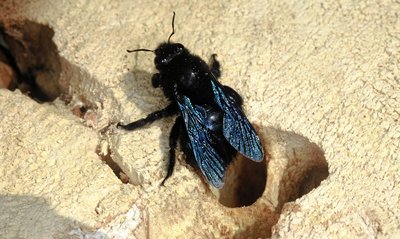The violet carpenter bee (Xylocopa violacea) is a wood dwelling bee species with a range of distribution from the Mediterranean to Asia. Its occurence in Germany was until now restricted to the warm areas. Since the year 2000 it seems that the species continues to spread. Since the violet carpenter bee is larger than the native german bumble bee species, its presence causes extreme fear by laypeople and leads to, as the following article shows, to completely excessive reactions.
Not unknown, but very rare
In a period of more than 150 years (from 1850-2004) only seventy-five reports of the violet carpenter bee have been documented in Bavaria. Since then the species has been observed in natural areas where it has never been seen before. In August of 2016 a panic stricken resident called the author. She asked for help since a large unknown winged insect was in her orchard and was surely up to no good. A previous consultation from an exterminator had no success since the "UFO" was not to be found in his book on household and food storage pests. A gardener was also asked for help and identified the object as a "large fruit tree moth" - a butterfly species that doesn't even exist (author's note).
Scientific name:
Xylocopaviolacea (L., 1758)
gr. Xylocopa = wood cutting;
lat. violaceum = violetFamily:
Bees (Apidae)
Description:
Body similar to a bumble bee, but 2.5 cm larger than native bumble bee species, covered in black hairs, wings with a metallic blue-violet luster.
Activity:
Times of light from April till October
Behavior:
They can sting, however, they are not aggressive
Habitat:
Sun-exposed, flower and dead wood rich orchards, gardens, parks, forest edges and lightly stocked forests
Nesting:
Nests in self gnawed galleries in wood already susceptible to breakage (branches, stems, stakes and beams)
Nourishment:
Larva feed in brooding galleries on "pollen cakes" carried in by adults
Economic meaningfulness:
None; the larvae do not feed on wood. The female only gnaws a nesting gallery to create a brooding chamber in woody substances already susceptible to breakage.
Status of endangerment:
Red list 3 in Bavaria "endangered"
What isn't known... ...will be struck dead!
At a local appointment in a beautiful old town garden with a mature stand of fruit trees the smoking gun was presented: An old apple tree, cut in meter-long pieces and stored in escape proof plastic bags. During the unpacking twelve dead and two living specimens of the violet carpenter bee were found. The heartwood of the tree was highly decomposed by the shaggy bracket fungus (Inonotus hispidulus). It was here that the bees established their brood in a textbook fashion. They acquire access from the surface through cracks caused by frost. The tree surely would have survived for several decades more, carried fruit and served as a living space for the bees. The owner of the garden admitted that the bees first showed up in 2006 and moved into the apple tree on the warm southern exposed side of the barn wall. Since the lady felt threatened by the bees she only went into the garden armed with a badminton racket. The last resort was to cut down the apple tree at night. Despite a large amount of mistrustfulness, there was at the same time a fascination which spurned the wish to release the two surviving bees from the plastic bags into her garden. Even as she removed the bees from the plastic bags with her bare hands the fear of the wild bees could not be diminished. In the not so rational conversation which followed, the question if the bees had ever behaved aggressively or stung anyone arose. Nothing of the sort had happened, however, simply the presence of the bees was perceived an unbearable threat to the lady.
Evidence is also in the forest
The literature names the habitat for the bee species in central Europe as orchards, gardens parks and forest edges. In other words, habitats with lightly stocked stands of trees with a high exposure to sunlight. In August of 2006 it was even more surprising to find the species "deep" in the forest of a nature conservation area. The site where the bee was found does in fact lie in a forest area, however, it was also on a wind-throw area where the tree density had been reduced and on a flower-rich inner forest edge. In the course of a continued warming of the climate the violet carpenter bee will continue to expand its range and due to its preference for open lands it will frequently come into contact with people. Based on previous experience it is doubtful that the harmlessness of the bee will be successfully conveyed to the general populace.

